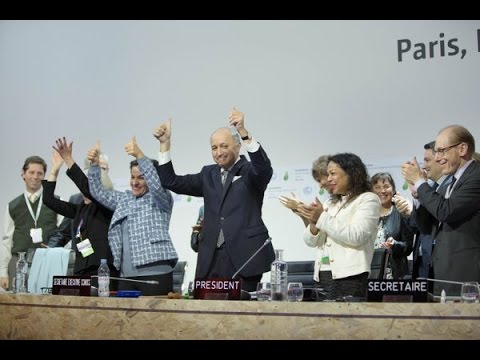The History of Nuclear Power: The Big Picture
Affiliate Disclosure
Hey fellow impactful ninja ?
You may have noticed that Impactful Ninja is all about providing helpful information to make a positive impact on the world and society. And that we love to link back to where we found all the information for each of our posts.
Most of these links are informational-based for you to check out their primary sources with one click.
But some of these links are so-called "affiliate links" to products that we recommend.
Why do we add these product links?
First and foremost, because we believe that they add value to you. For example, when we wrote a post about the environmental impact of long showers, we came across an EPA recommendation to use WaterSense showerheads. So we linked to where you can find them. Or, for many of our posts, we also link to our favorite books on that topic so that you can get a much more holistic overview than one single blog post could provide.
And when there is an affiliate program for these products, we sign up for it. For example, as Amazon Associates, we earn from qualifying purchases.
What do these affiliate links mean for you?
First, and most importantly, we still only recommend products that we believe add value for you.
When you buy something through one of our affiliate links, we may earn a small commission - but at no additional costs to you.
And when you buy something through a link that is not an affiliate link, we won’t receive any commission but we’ll still be happy to have helped you.
What do these affiliate links mean for us?
When we find products that we believe add value to you and the seller has an affiliate program, we sign up for it.
When you buy something through one of our affiliate links, we may earn a small commission (at no extra costs to you).
And at this point in time, all money is reinvested in sharing the most helpful content with you. This includes all operating costs for running this site and the content creation itself.
What does this mean for me personally?
You may have noticed by the way Impactful Ninja is operated that money is not the driving factor behind it. It is a passion project of mine and I love to share helpful information with you to make a positive impact on the world and society. However, it's a project in that I invest a lot of time and also quite some money.
Eventually, my dream is to one day turn this passion project into my full-time job and provide even more helpful information. But that's still a long time to go.
Stay impactful,
Nuclear power produces little to no carbon dioxide (CO2) emissions or other greenhouse gasses (GHGs). Despite facing criticism for its use of radioactive materials to generate electricity, nuclear power has evolved into our second-largest source of low-carbon energy today. So, we had to ask: What is the history of nuclear power?
Nuclear power began in the 1930s with the experimental and theoretical validation of nuclear reactions. Then, the first nuclear power plant was constructed in 1954. The post-World War II era saw rapid development and led to nuclear becoming our second-largest source of low-carbon energy today.
One way to combat the current global climate crisis threatening Earth’s environmental, economic, and social health is to transition away from traditional fossil fuels and toward cleaner energy sources, such as nuclear power. Keep reading to learn how nuclear power came to be, who and what pioneered its development, how effective it has been thus far, and what the future of nuclear power could entail.
Here’s the History of Nuclear Power in a Nutshell
In general, nuclear power is generated when neutrons either divide or fuse, which releases heat, produces steam, spins a turbine, and drives generators to produce electricity. These two ways we can generate nuclear power are via nuclear fission (when neutrons divide) or nuclear fusion (when neutrons fuse).
This means that the history of nuclear power is the history of both nuclear fission and nuclear fusion.
Nuclear fission is the generation of energy produced when splitting apart the nucleus of an atom.
“Nuclear fission: a nuclear reaction in which a heavy nucleus splits spontaneously or on impact with another particle, with the release of energy.”
Cambridge Dictionary
Nuclear fusion is the generation of energy produced when lighter atoms are combined or fused to create larger and heavier atoms.
“Nuclear fusion: the process of joining two nuclei to produce energy.”
Cambridge Dictionary
All operating nuclear power plants today utilize the process of nuclear fission, whereas nuclear fusion is still very much in the research and development phase.
Nuclear fission has gone through three distinct development phases in its development:
- Early market formation and innovation: The early history of nuclear power dates back to the late 1800s, with studies about the science of atomic radiation, the atomic model, and the naturally-occurring fission and fusion processes.
- Consolidation and strengthening: The first laboratory experiments and the validation of nuclear processes kickstarted the nuclear power movement, which saw rapid capacity and technology growth from 1950-2000.
- Mainstreaming: Nuclear power began to establish itself as a part of the mainstream electricity industry in the 1960s, with the opening of the first commercial nuclear power plants and rapid scaling of the technology post World War II. The establishment of the International Atomic Energy Agency (IAEA), the International Energy Agency (IEA), the World Nuclear Association (WNA), and the Paris Climate Agreement helped to regulate the nuclear energy market.
| Nuclear Power Milestones | Historical Event |
| Initial start | The early history of nuclear power dates back to the late 1800s, with studies about the science of atomic radiation, the atomic model, and the naturally-occurring fission and fusion processes. |
| Milestones in nuclear power development | 1929: Arthur Eddington first articulated the idea of nuclear fusion. 1934: Enrico Fermi unknowingly directed the first controlled chain reaction involving nuclear fission. Mark Oliphant demonstrated nuclear fusion in a laboratory setting and discovered helium-3 and tritium. 1938: Otto Hahn and Fritz Straßmann experimentally proved the process of nuclear fission. 1938: Lise Meitner and Otto Frisch theoretically proved the process of nuclear fission. 1939: Otto Frisch and William Arnold coined the term “fission”. Hans Bethe and Subrahmanyan Chandrasekhar figured out the precise subatomic process of fusion. 1939-1945: Nuclear development was focused on the making of the atomic bomb during World War II. 1950s: Andrei Sakharov and Igor Tamm conceptualized the tokamak, which would become the preferred nuclear fusion reactor today. 1951: Lyman Spitzer invented the stellarator, another type of fusion reactor. 1956: Calder Hall, the world’s first commercial nuclear fission power station, became operational. 1958: The Atoms for Peace conference opened the door to researching nuclear fusion for energy purposes. 1958: The world’s first tokamak fusion reactor, the T-1, was constructed in Russia. 1960-2000: Nuclear power generation increases from 25 TWh to over 2,500 TWh. 1983: The Joint European Torus (JET) tokamak was constructed, the largest operational nuclear fusion reactor to achieve nuclear fusion at the time. 1991: JET achieved the world’s first controlled release of fusion power. 2000-present: Nuclear power generation has remained relatively stable. Research into the process of nuclear fusion has increased. 2006: The International Thermonuclear Experimental Reactor (ITER) agreement was signed. 2021: The world record fusion power, 59 megajoules of energy, was achieved in The Joint European Torus (JET) tokamak fusion reactor. 2022: The National Ignition Facility at Lawrence Livermore National Laboratory in California (US) demonstrated the viability of nuclear fusion energy for the first time. |
| Current status | Currently, nuclear power accounts for roughly 10% of global electricity generation, generating approximately 2,500 TWh of electricity from approximately 413 GW of installed capacity. |
| Future outlook | The future of nuclear power faces an uncertain future. Although it can produce relatively emissions-free energy and adjust its energy output to compensate for shifts in renewable energy output, it also faces high upfront costs, technological barriers, and negative public opinion. |
| Key policy developments | 1957: International Atomic Energy Agency (IAEA) 1974: International Energy Agency (IEA) 1994: Nuclear Energy Institute (NEI) 1998: World Nuclear Transport Institute (WNTI) 2001: World Nuclear Association (WNA) 2006: The International Thermonuclear Experimental Reactor (ITER) Agreement and ITER Project 2015: Paris Climate Agreement 2018: The Fusion Industry Association (FIA) |
Understanding nuclear power’s history can provide insight into how it has evolved into the energy source it is today.
When and How Did Nuclear Power Get Started
Radioactivity has always been present on Earth, but it wasn’t seriously studied until the late 1800s. The early history of nuclear power involved studies about the science of atomic radiation, the atomic model, and the fission and fusion processes.
1789: German chemist Martin Klaproth discovered the element Uranium, which would become the foundation of modern nuclear fission.
1896: French physicist Henri Becquerel discovered the concept of radioactivity, the release of energy from atomic nuclei. His studies focused specifically on Uranium.
1897: British physicist J.J. Thompson discovered the electron, (he also received the Nobel Prize in Physics in 1906 for this discovery).
1911: New Zealand physicist Ernest Rutherford articulated his concept of the atom called “the Rutherford model”. It depicted a dense, positively-charged core called the nucleus surrounded by circulating, negatively-charged particles called electrons. This was the first primitive model of the atom.
1913: English chemist Frederick Soddy coined the term “isotope” to refer to chemically identical atoms with different atomic weights. Isotopes would become key in the formation of the modern nuclear industry.
1919: Danish physicist Niels Bohr articulated his concept of the atom called “the Bohr model”. His model was similar to Rutherford’s, but Bohr’s model depicted electrons that were confined to particular orbits, with electromagnetic radiation from an atom only occurring when electrons jumped to a lower-energy orbit. This was the first modern model of the atom.
1920: British astrophysicist Arthur Eddington theorized that stars get their energy from the fusion of hydrogen into helium. His theory laid the foundation of modern theoretical astrophysics.
1929: British and Dutch physicists Robert d’Escourt Atkinson and Fritz Houtermans suggested that fusing nuclei together could produce large amounts of energy. They also calculated the rate of nuclear fusion in stars.
1932: James Chadwick discovered the neutron, the part of the atom that is split apart during the process of nuclear fission. This led to the discovery that due to a differing number of neutrons, elements can exist at different weights but still have the same chemical properties.
How Has Nuclear Power Developed Over Time
Nuclear fission is currently our second-largest source of low-carbon energy behind hydropower energy. Pending further research and development, nuclear fusion could also play an important role in the global energy transformation.
What Are Milestones in Nuclear Power Development
The accidental creation of the first man-made nuclear chain reaction and the first laboratory experiment demonstrating nuclear fusion kickstarted the nuclear power movement, which saw rapid growth beginning in the 1950s.
1934: Italian physicist Enrico Fermi unknowingly directed the first controlled chain reaction involving nuclear fission. He bombarded more than 60 elements, one of which was Uranium, with neutrons. He thought he had produced elements beyond Uranium when he had actually split apart the atom.
1934: Ernest Rutherford fused deuterium into helium and observed an “enormous effect”, a release of energy. This would pave the way for modern nuclear fusion research.
1934: Australian physicist Mark Oliphant became the first to demonstrate nuclear fusion in a laboratory setting. He also discovered helium-3 and tritium, both of which are used in nuclear fusion, and the fusion reaction which formed the basis for a hydrogen bomb.
1938: German radiochemists Otto Hahn and Fritz Straßmann experimentally proved the process of nuclear fission. Bombarding Uranium with neutrons produced barium, which was deemed too light to be just a decay product of Uranium. They hypothesized that the Uranium atom had been split into two distinct atoms. This discovery would shape the modern nuclear industry.
1938: Austrian physicists Lise Meitner and Otto Frisch theoretically proved the process of nuclear fission, the splitting of the Uranium atom, which was carried out experimentally by Hahn and Fritz.
1939: Otto Frisch and William Arnold coined the term “fission” to refer to the splitting of an atomic nucleus.
1939: German and Indian physicists Hans Bethe and Subrahmanyan Chandrasekhar demonstrated that stars are fueled by nuclear fusion. They identified the “proton-proton chain”, which is the process that enables stars to generate energy and the model for modern fusion.
1939-1945: Most nuclear development was focused on the making of the atomic bomb during World War II.
1950s: Soviet scientists Andrei Sakharov and Igor Tamm conceptualized the tokamak, which, like the stellarator, used magnetic fields to control plasma particles and maintain the right conditions for fusion reactions to occur. Tokamaks are the preferred option today for nuclear fusion energy power plants because they are easier to build than stellarators and are better at keeping plasmas hot.
1951: Lyman Spitzer invented the stellarator, a machine that uses magnetic fields to control plasma particles and maintain the right conditions for fusion reactions to occur. This was the first model for harnessing fusion reactions.
1956: Calder Hall, the world’s first commercial nuclear power station, became operational in the United Kingdom. It had a 49 MW capacity and remained operational for 47 years before closing in 2003.
1958: Nuclear fusion research was declassified at the Atoms for Peace conference in Geneva, which opened the door to researching fusion for energy purposes. Previously, nuclear fusion research was linked only to atomic weapons development.
1958: The world’s first tokamak fusion reactor, the T-1, was constructed in Russia.
1960-2000: Nuclear power generation increased from 25 TWh to over 2,500 TWh as more and more power stations were constructed worldwide.
1983: The Joint European Torus (JET), the largest operational nuclear fusion reactor to achieve nuclear fusion at the time, was constructed.
1991: JET achieved the world’s first controlled release of fusion power. Previously, fusion reactions had only taken place uncontrollably via hydrogen bombs.
2000-present: Nuclear power generation has remained relatively stable. Research into the process of nuclear fusion, the other way to generate nuclear power, has increased.
2006: The International Thermonuclear Experimental Reactor (ITER) agreement was signed, and the ITER project was formed. ITER is both an international cooperation between 35 countries and the name of what will be the world’s largest and most advanced tokamak reactor.
2021: The world record fusion power was achieved in The Joint European Torus (JET) tokamak. JET produced 59 megajoules of energy, double the previous record amount. It was also the first reactor to run off of a 50-50 mix of tritium and deuterium.
2022: The National Ignition Facility at Lawrence Livermore National Laboratory in California (US) demonstrated the viability of nuclear fusion energy for the first time ever when a fusion reaction produced more energy than was needed to spark the reaction. The machine’s laser fired 2 megajoules onto a target and produced 3 megajoules of energy.
How Has the Nuclear Power Market Developed Recently
Beginning in 1950, both the nuclear fission and nuclear fusion industries saw rapid growth. In more recent years, nuclear fission has seen a relatively stable market, with slight decreases in installed capacity and electricity output.
- 2019: Installed nuclear fission capacity increased from 2018 to 399 GW, with 450 nuclear power reactors in operation worldwide.
- 2020: Installed nuclear fission capacity decreased to 393 GW, with 442 nuclear power reactors in operation worldwide.
- 2021: Installed nuclear fission capacity decreased to 389 GW, with 437 nuclear power reactors in operation worldwide.
- 2022: Installed nuclear fission capacity decreased to 371 GW, with 411 nuclear power reactors in operation worldwide.
- 2023: Experts predict nuclear fission capacity and demand to grow. There are currently about 60 nuclear reactors under construction in 15 countries, mostly in Asia and Russia.
Nuclear fusion currently does not currently supply energy to the power grid. The focus remains on refining the technology and increasing investments.
The most recent breakthroughs for nuclear fusion came first in 2021, when The Joint European Torus (JET) held a nuclear fusion reaction for 5 seconds to produce 59 megajoules (MJ) of energy, almost double that of the previous record. However, scientists had to put 3x as much energy into the system as was created by the reaction.
And then in December 2022, The National Ignition Facility at Lawrence Livermore National Laboratory in California (US) created a fusion reaction that produced more energy than was needed to spark the reaction. The machine’s laser fired 2 megajoules onto a target and produced 3 megajoules of energy. This demonstrated the viability of nuclear fusion energy for the first time ever.
What Is the Present Status of Nuclear Power
Nuclear fission accounted for roughly 10% of global electricity generation in 2022, generating approximately 2,500 TWh of electricity from approximately 413 GW of installed capacity.
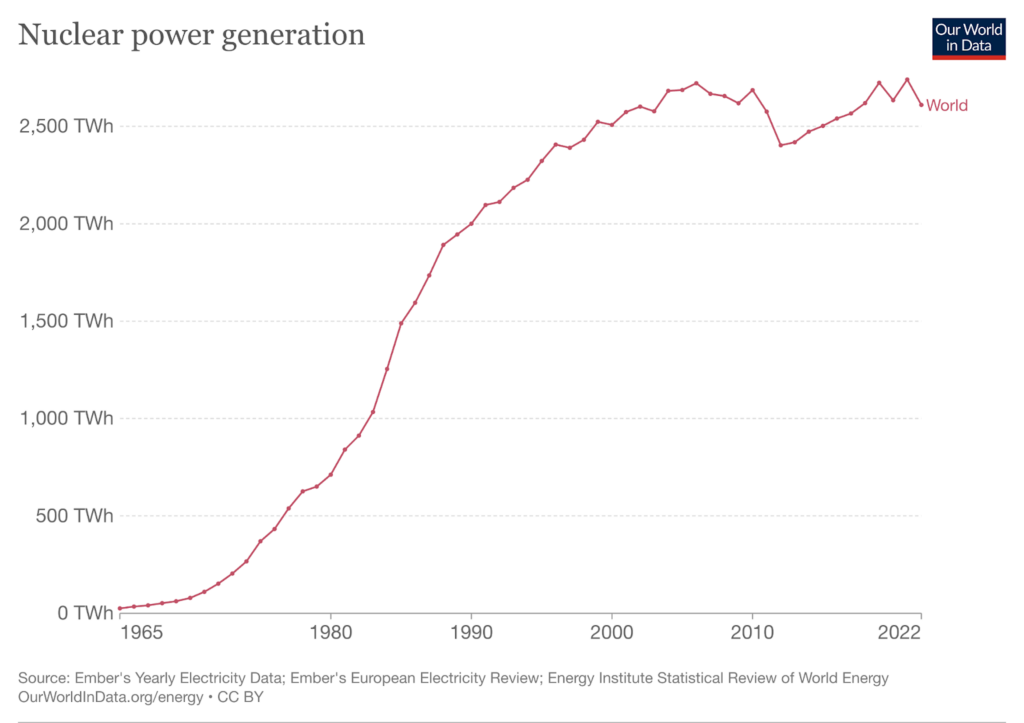
The 5 countries with the highest nuclear power production (amount produced per year) are:
- US – 772 TWh
- China – 395 TWh
- France – 282 TWh
- Russia – 209 TWh
- Republic of Korea – 167 TWh
Some countries rely heavily on nuclear power (nuclear fission) whilst others have not yet tapped into the resource. For example, nuclear power provides roughly 60% of France, Slovakia, and Ukraine’s electricity, but South America and Africa get virtually no energy from nuclear. The top 5 countries represent roughly 70% of the world’s nuclear power generation.
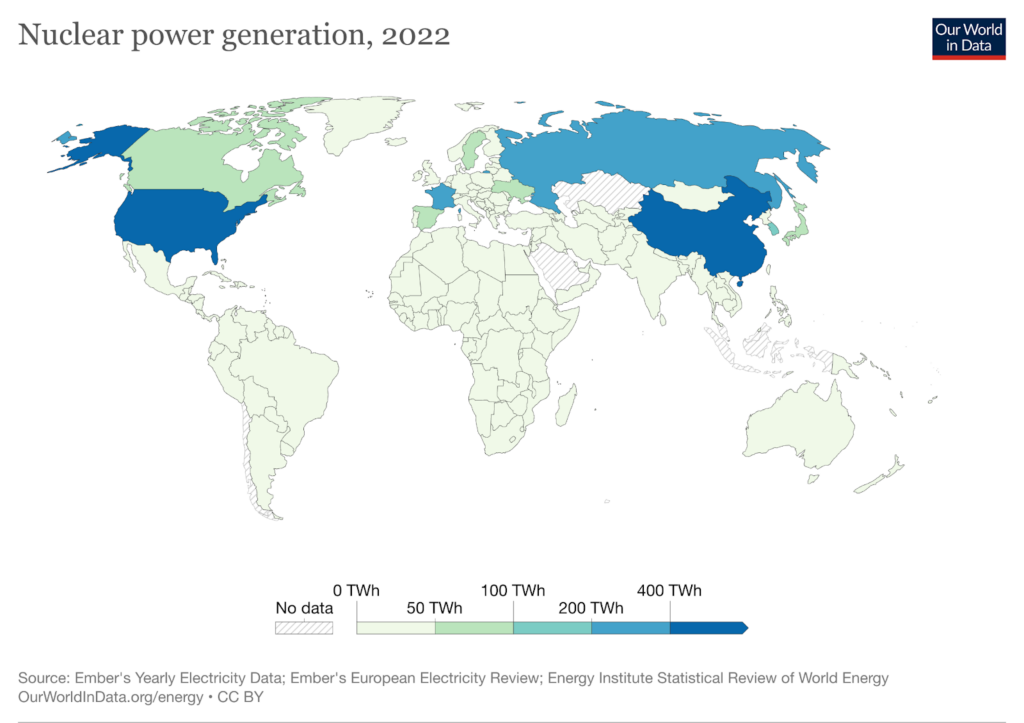
In terms of nuclear fusion, there are currently more than 10 stellarators and 50 tokamaks in operation worldwide, but there are currently no operating reactors that provide energy to our power grid.
ITER, the world’s largest tokamak, is currently being built in France. Weighing 23,00 tons, the machine will be able to maintain a temperature 10x that of the sun’s core and will have a 500 MW fusion energy output power once constructed. Although it will not be used to generate electricity, the technology of ITER will set the standard for future reactors.
How Will the Future of Nuclear Power Look Like
Nuclear fission is predicted to continue to play a key role in the clean energy movement for years to come because it can produce relatively emissions-free energy and adjust its energy output to compensate for shifts in renewable energy output despite facing high upfront costs and negative public opinion.
Nuclear fusion offers the prospect of an inexhaustible energy source for future generations, but it has been held back thus far by unresolved engineering challenges. Achieving nuclear fusion energy commercialization will require increased funding and research.
How Nuclear Power Will Likely Develop in the Future
Overall, the IEA has labeled nuclear power as ‘more efforts needed’ in their Net Zero by 2050 Scenario in terms of capacity and investments.
In terms of capacity additions, nuclear power capacity must increase from 414 GW to 545 GW by 2030 to stay on track in the net zero scenario. Currently, there are about 60 nuclear fission reactors under construction in 15 countries, most notably in China, India, and Russia.
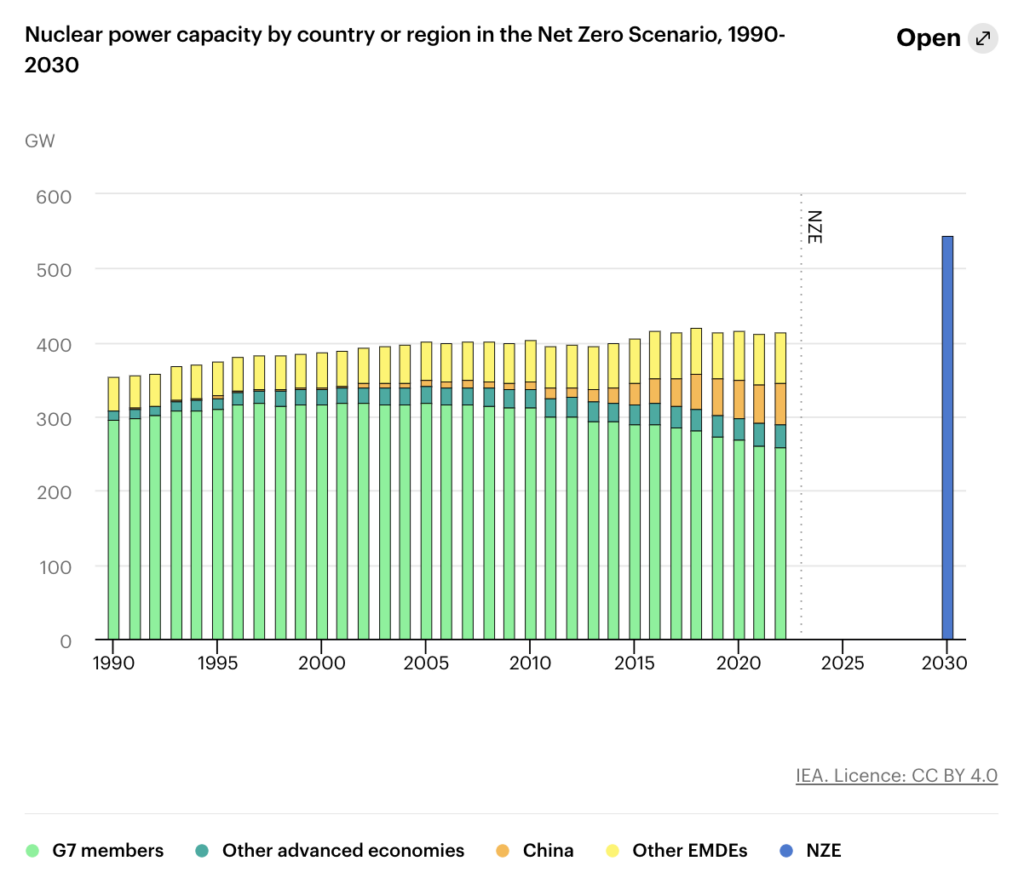
In terms of funding, nuclear power investment must triple to $125 billion per year to stay on track in the net zero scenario. Investment averaged only $40 billion per year from 2016-2022, but the Intergovernmental Panel on Climate Change (IPCC) predicts global investments to increase to over $100 billion per year through 2050.
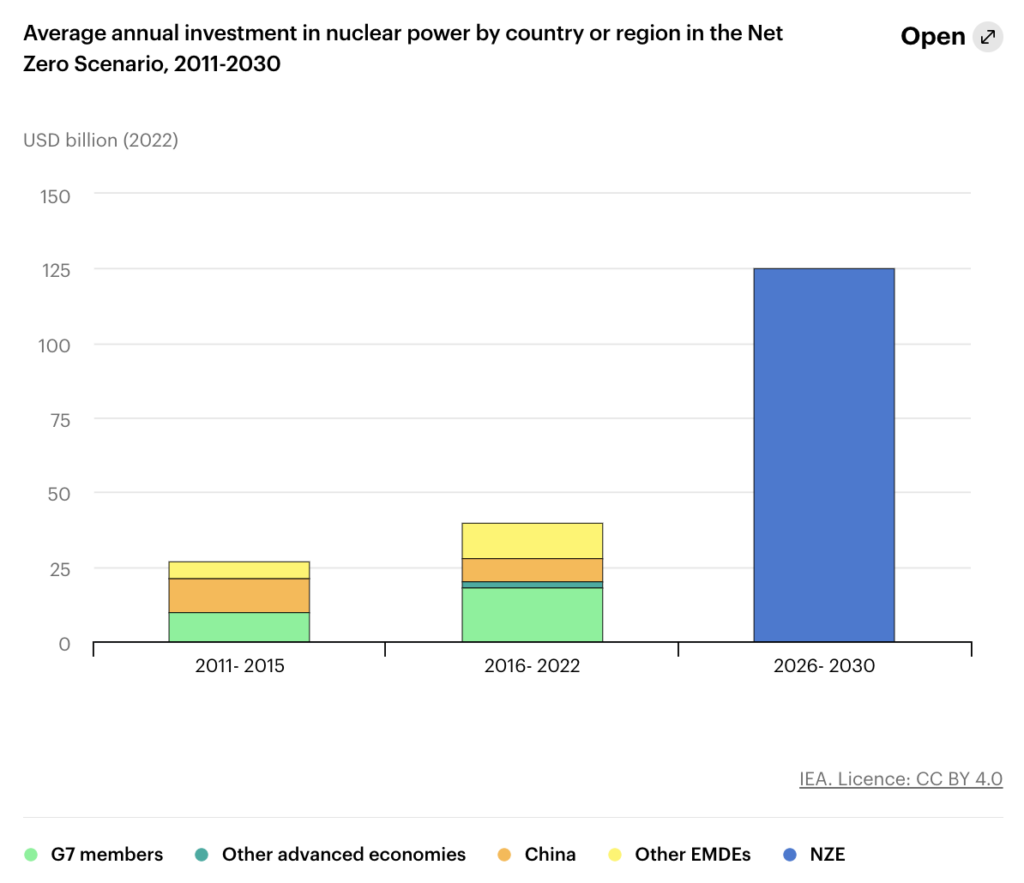
In terms of nuclear fusion, most experts agree that we are unlikely to achieve large-scale energy generation before 2050. This means that fusion is not an option for meeting the short-term climate goals laid out in The Paris Climate Agreement, which aims to limit global warming to below 2 degrees Celsius (C).
But that doesn’t mean we should give up on nuclear fusion. Nuclear fusion can become a commercially viable energy source if we develop a steady and reliable way of maintaining the fusion reaction.
In terms of funding, nuclear fusion investments grew 27% to over $6 billion in 2022. But this is still much less than will be required in the future, given that the cost of ITER is over $20 billion alone. Nuclear fusion is a capital-intensive process; therefore, investments will need to increase before the technology can become commercially viable.
In addition, we must overcome the two main challenges to nuclear fusion: maintaining the reaction and generating more energy from the reaction than was required to start the reaction. This will require increased funding and further technological advancements.
What Policies Are Put in Place to Support/Reduce Nuclear Power Usage
The most well-known piece of legally binding, international climate mitigation legislation is The Paris Agreement, the goal of which is to limit global warming to below 2 degrees Celsius (C), preferably to 1.5C, compared to pre-industrial levels.
The Paris Agreement specifically notes a transition towards clean energies, such as nuclear power, as being a critical part of meeting these goals.
Check out the highlights of the 2015 COP21 directly from the UN Climate Change channel:
In addition, The International Energy Agency’s (IEA) Net Zero Emissions by 2050 Scenario is one framework for the global energy sector to achieve net zero CO2 emissions by 2050 and universal energy access by 2030.
There are many global nuclear power policies and organizations aimed at meeting the 2050 net zero scenario, including:
- 1957 – International Atomic Energy Agency (IAEA): The IAEA was founded as fears about nuclear technology began to develop. It is an organization within the United Nations that seeks to promote the safe, secure, and peaceful use of nuclear technologies through international cooperation.
- 1974 – The International Energy Agency (IEA): The IEA was founded in response to the major oil disruptions in 1974. It promotes international energy cooperation, including nuclear power, and is made up of 31 member countries.
- 1994 – Nuclear Energy Institute (NEI): The NEI was founded as the policy organization of the nuclear power industry. They seek to promote the global growth of nuclear power through effective policies.
- 1998 – World Nuclear Transport Institute (WNTI): The WNTI was founded to represent the collective interests of the nuclear transport industry. They aim to ensure safety and security in the global transport of nuclear materials.
- 2001 – World Nuclear Association (WNA): The WNA was established as the leading international organization to represent the global nuclear industry.
- 2006 – The ITER Agreement: ITER is a global scientific partnership established as a collaborative international project to develop fusion energy for peaceful purposes. Upon construction, the ITER tokamak will be the largest magnetic confinement fusion experiment in the world.
- 2018 – The Fusion Industry Association (FIA): The FIA was formed to be the voice of the private fusion industry. They are a nonprofit organization comprised of private companies striving to make nuclear fusion commercially viable.
If you are interested in learning more about country-specific nuclear power policies, you can visit the IEA’s nuclear power policy database.
What Are Currently the Different Types of Nuclear Power
In general, nuclear power is generated when neutrons either fuse or divide, which releases heat, produces steam, spins a turbine, and drives generators to produce electricity. The two ways we can generate nuclear power are via nuclear fission or nuclear fusion.
Nuclear Fission Is How We Currently Produce Nuclear Power
Nuclear fission is the process by which neutrons are used to split the nucleus of an atom, which releases an enormous amount of energy in the form of heat and radiation.
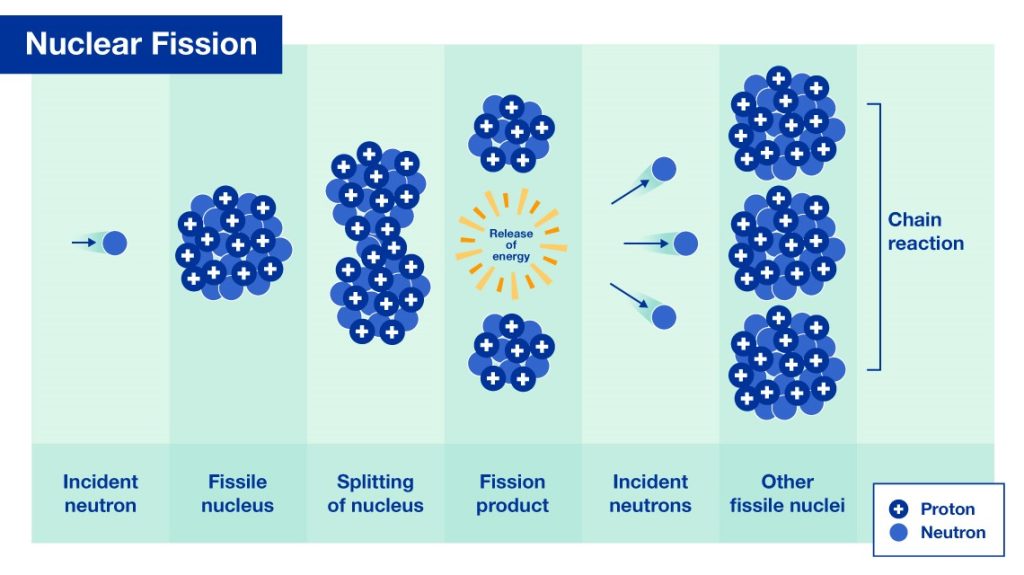
Uranium-235 (U-235) is the isotope of Uranium used in nuclear fission because its atoms are easily split apart in nuclear reactors. Each time the reaction occurs, more neutrons are free to strike more and more nuclei, causing a chain reaction that turns a turbine and spins a generator to produce electricity.
Nuclear fission is expected to continue to play a key role in the clean energy movement. This is because nuclear power:
- Has a low carbon footprint: On a life-cycle basis, nuclear power (nuclear fission) emits 12 grams of CO2 equivalent per kilowatt-hour (kWh) of electricity produced, which is tied for the third-lowest out of all energy types.
- Has a minimal land use impact: Nuclear power produces more electricity on less land than any other clean-air source. A standard, 1,000-megawatt facility requires only a little more than 1 square mile to operate, a number that is 360 and 75 times less than what is required for wind farms and solar power plants, respectively.
- Generates very little waste: A typical 1,000-megawatt facility produces only three cubic meters of nuclear waste. In comparison, the average coal-fired power plant produces roughly 300,000 tons of coal ash and more than 6 million tons of CO2 every year.
- Promotes energy security: Nuclear power contributes to energy security by increasing the stability of our power grids. Unlike renewable energy, which faces variations in supply and demand, nuclear power can provide a reliable and consistent source of clean energy.
Nuclear Fusion Is Still in the Research and Development Phase
Nuclear fusion is the process by which lighter atoms are combined or fused to create larger and heavier atoms. The sun and stars get their energy from nuclear fusion, as hydrogen atoms fuse together to form helium and matter converts into energy.
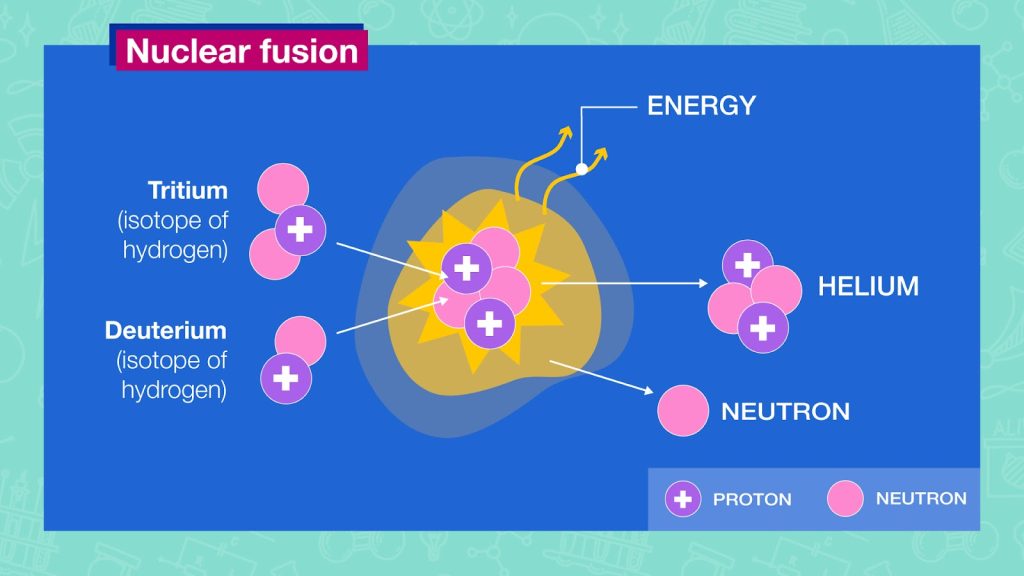
Fusion reactions take place inside fusion reactors in plasma, a hot, charged gas made of positive ions and free-moving electrons. Deuterium and tritium, isotopes of hydrogen with extra neutrons, are the most commonly used nuclear fusion materials.
The two most common fusion reactors in use today are tokamaks and stellarators. Both use magnetic fields to confine plasma in the shape of a donut.
- Tokamaks: Induce electric currents inside of the plasma. Tokamaks are easier to build than stellarators and are better at keeping plasmas hot. They are the preferred option today for nuclear fusion energy power plants.
- Stellarators: Use external coils to generate a twisting magnetic field. They require less injected power, have greater design flexibility, and are better at keeping plasma stable than tokamaks. However, they are also more complex to build.
Nuclear fusion is very hard to control within a laboratory setting; therefore, nuclear fusion is still very much in the research and development phase. More still needs to be done to determine if it could be another viable energy source.
If the technology is developed, nuclear fusion could play a key role in the clean energy movement. This is because nuclear fusion:
- Has a low carbon footprint: Nuclear fusion produces little to no greenhouse gas emissions and toxic byproducts, making it one of our most environmentally-friendly sources of energy. One study on tokamak fusion power plants found that they emit less CO2 than photovoltaic solar systems and less than double those from nuclear fission reactors.
- Efficiently produces a lot of energy: Theoretically, it is possible to produce one terajoule of energy with just a few grams each of Deuterium and Tritium. This would be enough to meet the needs of an adult person living in the developed world for 60 years. Estimates also suggest that nuclear fusion alone could generate up to 4 times more energy per kilogram of fuel than nuclear fission and nearly 4 million times more energy than burning oil or coal.
- Uses materials that are readily available: The fusion reaction is most readily feasible between deuterium and tritium, two isotopes of hydrogen. Deuterium is naturally abundant in seawater, and tritium can be bred from lithium, which is naturally abundant in the Earth’s crust and in seawater. Compare this to Uranium-235, the ingredient for nuclear fission, which has a concentration of only 2.8 parts per million (0.7% abundance) in the Earth’s crust.
- Does not produce nuclear waste: Unlike nuclear fission, nuclear fusion reactions do not produce long-lived nuclear wastes. The only byproducts are helium (an inert gas) and tritium. Although tritium is radioactive, it is produced and consumed within the plant in a closed circuit and is only used in low amounts.
- Cannot cause a nuclear accident: Unlike nuclear fission, nuclear fusion reactions are not based on chain reactions. Plasma must be kept at very high temperatures and pressures, with the support of external heating systems and magnetic fields. If there is a loss of pressure or temperature, the reactor shuts down with no adverse effects to the outside world.
- Cannot be used to produce nuclear weapons: Hydrogen bombs do use fusion reactions; however, they require an additional nuclear fission bomb to detonate. Fusion fuel is also continuously injected and consumed in fusion reactors, so there is never enough fuel lying around to produce a weapon.
- Promotes energy security: Nuclear power contributes to energy security by increasing the stability of our power grids. Unlike renewable energy, which faces variations in supply and demand, nuclear power can provide a reliable and consistent source of clean energy.
Final Thoughts
The early history of nuclear fission and fusion dates back to the late 1800s, with studies about the science of atomic radiation, the atomic model, and the fission and fusion processes. When Enrico Fermi unknowingly directed the first man-made nuclear chain reaction and Mark Oliphant demonstrated nuclear fusion in a laboratory setting in 1934, it kickstarted the nuclear power movement. Once both processes were experimentally and theoretically verified, the industry saw rapid growth beginning in 1950.
Nuclear fission is currently our second-largest source of low-carbon energy behind hydropower energy. Nuclear fusion does not currently supply energy to our power grid, but the focus remains on refining the technology and increasing investments. The formation of the International Energy and World Nuclear Association plus the implementation of the Paris Climate Agreement Climate has propelled nuclear power into the spotlight as one replacement for traditional fossil fuels.
Nuclear power faces an uncertain future. Although nuclear fission can produce relatively emissions-free energy and adjust its energy output to compensate for shifts in renewable energy output, it also faces high upfront costs and negative public opinion. And most experts agree that we are unlikely to achieve large-scale nuclear fusion energy generation before 2050. Despite all of this, experts still predict that nuclear power, specifically nuclear fission, will play a key role in the clean energy movement for years to come.
Stay impactful,

Sources
- Impactful Ninja: Nuclear Power Explained – All You Need to Know
- The International Atomic Energy Agency: What is Nuclear Energy? The Science of Nuclear Power
- World Nuclear Association: Nuclear Fusion
- The International Atomic Energy Agency: Homepage
- The International Energy Agency: Homepage
- The World Nuclear Association: Homepage
- International Thermonuclear Experimental Reactor (ITER) Agreement
- Fusion Industry Association: Homepage
- The World Nuclear Association: What is Uranium? How Does it Work?
- The Atomic Heritage Foundation: Timeline – Nuclear Museum
- The Nobel Prize: Henri Becquerel
- US Energy Information Administration: Nuclear Timeline
- Britannica: J.J. Thompson
- Britannica: Rutherford Model
- Britannica: Ernest Rutherford
- National Library of Medicine – National Center for Biotechnology Information: Frederick Soddy – Pioneer in Radioactivity
- US Department of Energy: Manhattan Project – A Miniature Solar System
- Britannica: Niels Bohr
- EUROfusion: History of fusion
- Britannica: Arthur Eddington
- Social Networks and Archival Context: Atkinson, Robert d’Escourt, 1898-1982
- US Department of Energy: Manhattan Project – Exploring the Atom
- Britannica: Enrico Fermi
- International Atomic Energy Agency: What is Deuterium?
- The Atomic Heritage Foundation: Mark Oliphant
- Encyclopedia of World Biography: Mark Oliphant Biography
- Nobel Prize: Otto Hahn
- Britannica: Otto Hahn
- Britannica: Fritz Straßmann
- Britannica: Lise Meitner
- Britannica: Otto Robert Frisch
- US Department of Energy: Manhattan Project – Hans Bethe
- The Nobel Prize: Subrahmanyan Chandrasekhar
- World Nuclear Association: Outline History of Nuclear Energy
- The Nobel Prize: Andrei Sakharov
- The Nobel Prize: Igor Tamm
- US Department of Energy – Office of Science: DOE Explains…Tokamaks
- Science: The bizarre reactor that might save nuclear fusion
- Britannica: Lyman Spitzer
- US Department of Energy – Office of Science: DOE Explains…Stellarators
- Institution of Civil Engineers: Calder Hall nuclear power station
- Britannica: Calder Hall Reactor
- ITER: Two Weeks In September, 1958: Atoms For Peace Conference In Geneva
- Our World in Data: Nuclear Energy
- EUROfusion: JET
- ITER: Milestones around the world
- International Atomic Energy Agency: What is Nuclear Fusion?
- ITER: The ITER Agreement
- Fusion Industry Association: The global fusion industry in 2023
- Lawrence Livermore National Laboratory: The Age of Ignition – Inside LLNL’s Fusion Breakthrough
- The International Atomic Energy Agency: Preliminary Nuclear Power Facts and Figures for 2019
- The International Atomic Energy Agency: Nuclear Power Proves its Vital Role as an Adaptable, Reliable Supplier of Electricity during COVID-19
- The International Atomic Energy Agency: Amid Global Crises, Nuclear Power Provides Energy Security with Increased Electricity Generation in 2021
- Statista: Capacity of nuclear power plants in operation worldwide from 1954 to 2022
- World Nuclear Association: Plans for new reactors
- Science: European fusion reactor sets record for sustained energy
- International Energy Agency: Nuclear
- World Nuclear Association: World Nuclear Performance Report 2023
- Our World in Data: Nuclear power generation
- Our World in Data: Nuclear power generation, 2022
- The International Atomic Energy Agency: Tokamaks, Stellarators, Laser-based and Alternative Concepts: Report Offers Global Perspective on Nuclear Fusion Devices
- ITER: Machine
- International Energy Agency: Nuclear power capacity by country or region in the Net Zero Scenario, 1990-2030
- International Energy Agency: Average annual investment in nuclear power by country or region in the Net Zero Scenario, 2011-2030
- Intergovernmental Panel on Climate Change: Homepage
- Scientific American: What is the future of fusion energy?
- United Nations Framework Convention on Climate Change: The Paris Agreement
- Scientific American: World’s Largest Fusion Project Is in Big Trouble, New Documents Reveal
- The International Energy Agency: Net Zero Emissions by 2050 Scenario
- Nuclear Energy Institute: Homepage
- World Nuclear Transport Institute: Homepage
- The International Energy Agency: Policies Database
- Impactful Ninja: Nuclear Energy Explained – All You Need to Know
- Britannica: Fissile Material
- US Department of Energy – Office of Nuclear Energy: Fission and Fusion: What is the Difference?
- World Nuclear Association: Carbon Dioxide Emissions From Electricity
- US Department of Energy – Office of Nuclear Energy: 3 Reasons Why Nuclear is Clean and Sustainable
- World Nuclear Association: What is nuclear waste, and what do we do with it?
- International Energy Agency: Nuclear
- Impactful Ninja: The History of Nuclear Fission – The Big Picture
- Britannica: Tritium
- International Atomic Energy Agency: What is Deuterium?
- International Atomic Energy Agency: Magnetic Fusion Confinement with Tokamaks and Stellarators
- International Atomic Energy Agency: Fusion – Frequently asked questions
- IOP Science: Evaluation of CO2 emissions in the life cycle of tokamak fusion power reactors
- World Nuclear Association: Uranium Mining Overview
- Impactful Ninja: The History of Nuclear Fusion: The Big Picture
